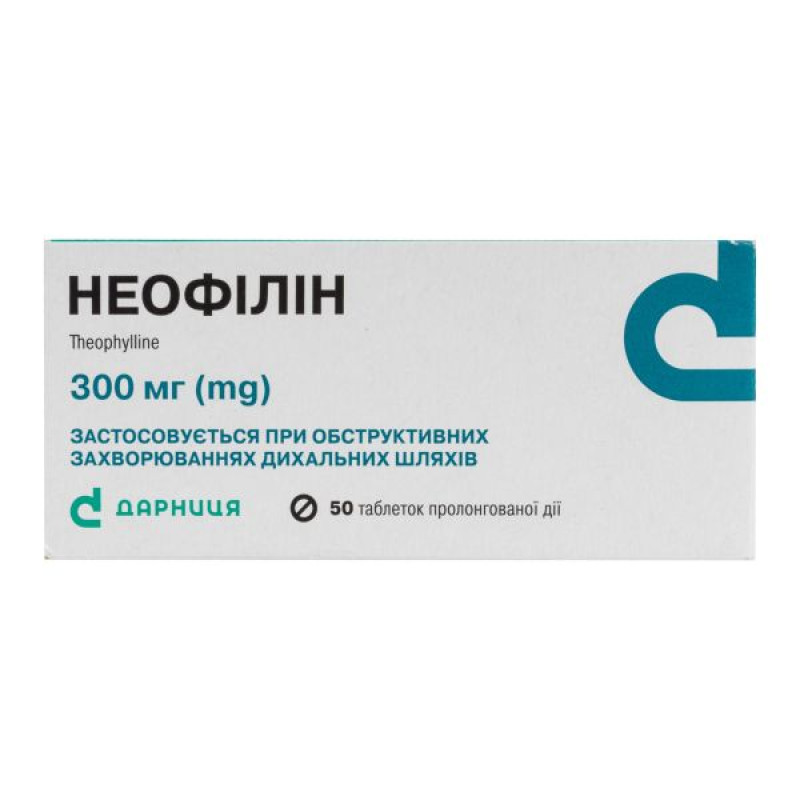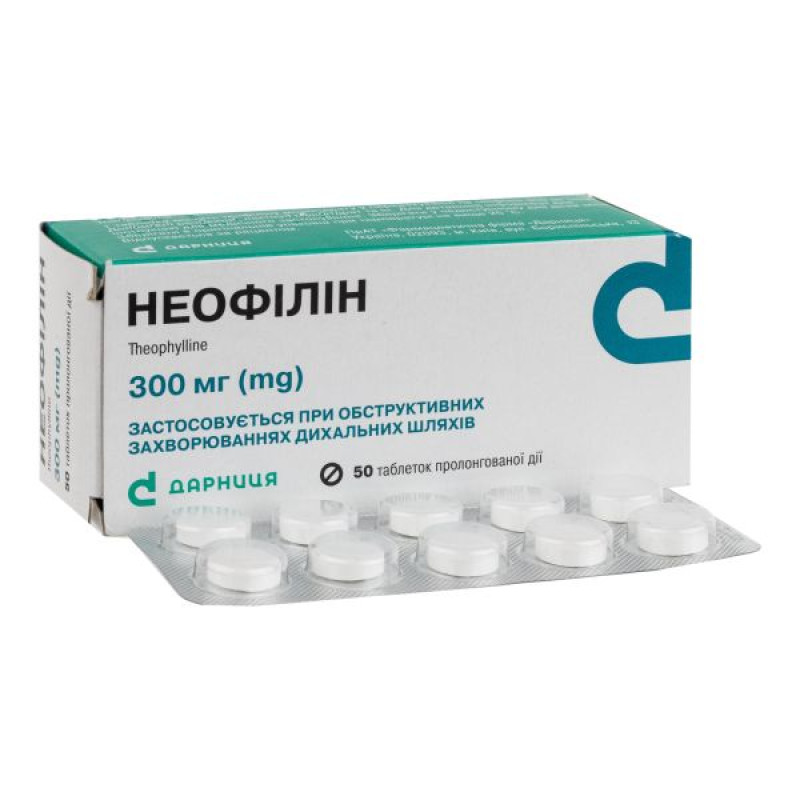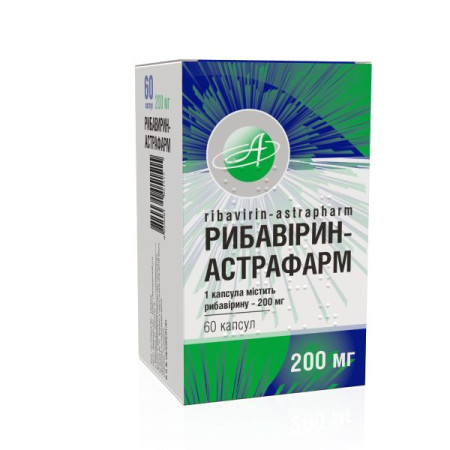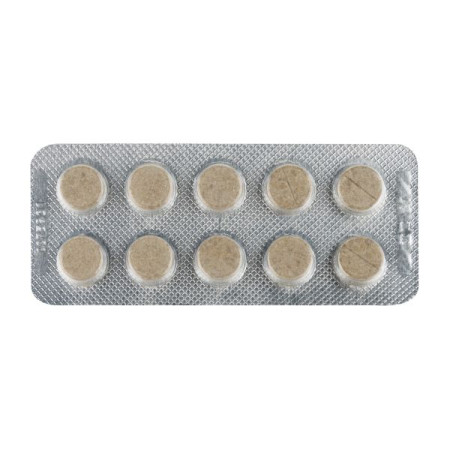Neofilin prolonged-release tablets 300 mg No. 50
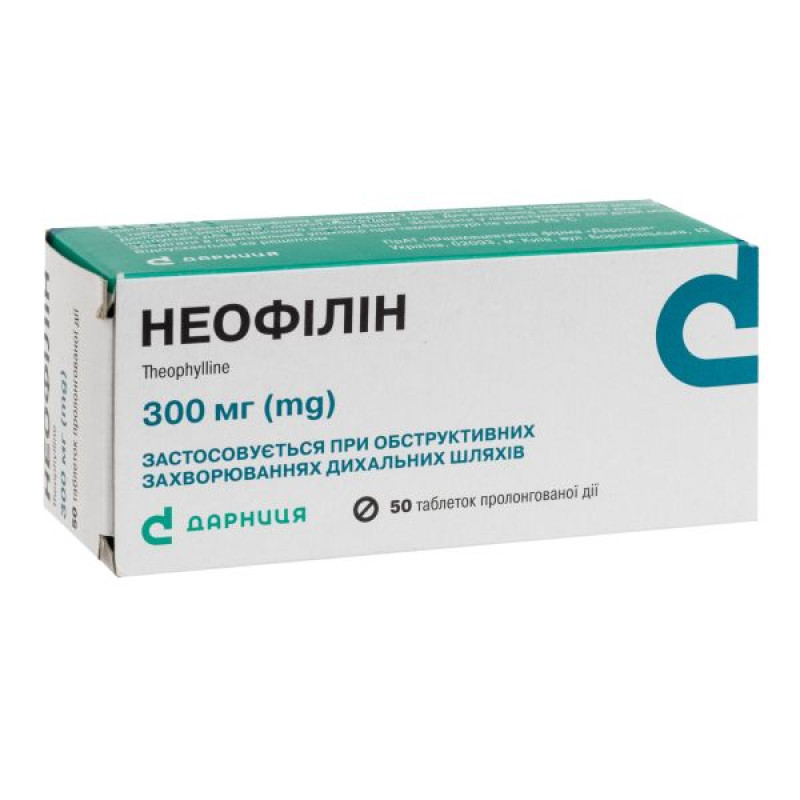
Instructions for Neophilin prolonged-release tablets 300 mg No. 50
Composition
active ingredient: theophylline;
1 tablet contains theophylline monohydrate equivalent to theophylline 300 mg;
excipients: lactose monohydrate, ammonium methacrylate copolymer dispersion, methacrylate copolymer dispersion, magnesium stearate, talc.
Dosage form
Extended-release tablets.
Main physicochemical properties: 300 mg tablets - white, flat-cylindrical, with a bevel and a score.
Pharmacotherapeutic group
Means for systemic use in obstructive airway diseases. Xanthines. Theophylline. ATC code R03D A04.
Pharmacological properties
Pharmacodynamics
Theophylline is a bronchodilator of the methylxanthine group. The mechanism of action is mainly due to the blocking of adenosine receptors, inhibition of phosphodiesterases, an increase in the content of intracellular cAMP, a decrease in the intracellular concentration of calcium ions, as a result of which the smooth muscles of the bronchi, gastrointestinal tract, biliary tract, uterus, coronary, cerebral and pulmonary vessels relax, peripheral vascular resistance decreases; the tone of the respiratory muscles (intercostal muscles and diaphragm) increases, the resistance of the pulmonary vessels decreases and blood oxygenation improves, the respiratory center of the medulla oblongata is activated, its sensitivity to carbon dioxide increases, alveolar ventilation improves, which leads to a decrease in the severity and frequency of apnea episodes; eliminates angiospasm, increases collateral blood flow and blood oxygen saturation, reduces perifocal and general brain edema, reduces cerebrospinal fluid and, accordingly, intracranial pressure; improves the rheological properties of blood, reduces thrombus formation, inhibits platelet aggregation (by inhibiting platelet activation factor and prostaglandin F2α), normalizes microcirculation; exhibits an antiallergic effect by inhibiting mast cell degranulation and reducing the level of allergy mediators (serotonin, histamine, leukotrienes); enhances renal blood flow, exhibits a diuretic effect due to a decrease in tubular reabsorption, increases the excretion of water, chlorine ions, and sodium.
Pharmacokinetics
When taken orally, theophylline is completely absorbed in the gastrointestinal tract, the bioavailability is approximately 90%. When taking theophylline in the form of prolonged-release tablets, the maximum concentration is reached after 6 hours. Binding to blood plasma proteins is: in healthy adults - approximately 60%, in patients with cirrhosis of the liver - 35%. Penetrates through histohematological barriers, distributing in tissues. Approximately 90% of theophylline is metabolized in the liver with the participation of several cytochrome P450 isoenzymes to inactive metabolites - 1,3-dimethyluric acid, 1-methyluric acid and 3-methylxanthine. Excreted mainly by the kidneys in the form of metabolites; in an unchanged state, up to 13% is excreted in adults, up to 50% in children. Partially penetrates into breast milk. The half-life of theophylline depends on age and the presence of concomitant diseases and is: in adult patients with bronchial asthma - 6-12 hours; in children from 6 months of age - 3-4 hours; in smokers - 4-5 hours; in the elderly and in heart failure, liver dysfunction, pulmonary edema, chronic obstructive pulmonary disease and bronchitis - more than 24 hours, which requires appropriate correction of the interval between taking the drug.
Therapeutic concentrations of theophylline in the blood are: to achieve a bronchodilator effect - 10-20 μg/ml, for a stimulating effect on the respiratory center - 5-10 μg/ml. Toxic concentrations - more than 20 μg/ml.
Indication
bronchial asthma; chronic obstructive pulmonary diseases (chronic obstructive bronchitis, pulmonary emphysema); pulmonary hypertension; central sleep apnea syndrome.
Contraindication
Increased individual sensitivity to the components of the drug, as well as to other xanthine derivatives (caffeine, pentoxifylline, theobromine), acute heart failure, angina pectoris, acute myocardial infarction, acute cardiac arrhythmias, paroxysmal tachycardia, extrasystole, severe arterial hypertension and hypotension, widespread atherosclerosis of blood vessels, pulmonary edema, hemorrhagic stroke, glaucoma, retinal hemorrhage, history of bleeding, gastric and duodenal ulcer (in the acute stage), gastroesophageal reflux, epilepsy, increased convulsive readiness, uncontrolled hypothyroidism, hyperthyroidism, thyrotoxicosis, impaired liver and/or kidney function, porphyria, sepsis, use in children simultaneously with ephedrine.
Interaction with other medicinal products and other types of interactions
Drugs that reduce theophylline clearance: allopurinol, acyclovir, carbimazole, phenylbutazone, fluvoxamine, imipenem, isoprenaline, cimetidine, fluconazole, furosemide, pentoxifylline, disulfiram, interferon, nizatidine, calcium antagonists (verapamil, diltiazem), amiodarone, paracetamol, probenecid, ranitidine, tacrine, propafenone, propanolol, oxpentifylline, isoniazid, lincomycin, methotrexate, zafirlukast, mexiletine, fluoroquinolones (ofloxacin, norfloxacin, when using ciprofloxacin, the dose must be reduced by at least 60%, enoxacin - by 30%), macrolides (clarithromycin, erythromycin), ticlopidine, thiabendazole, viloxazine hydrochloride, oral contraceptives, influenza vaccine. In patients taking one or more of the above-mentioned drugs in parallel with theophylline, the serum theophylline concentration should be monitored and the dose reduced if necessary.
Theophylline plasma concentrations may be reduced when theophylline is administered concomitantly with herbal medicinal products containing St. John's wort (Hypericum perforatum).
Concomitant use of theophylline and phenytoin may cause a decrease in the level of the latter.
Ephedrine enhances the effect of theophylline.
The combination of theophylline and fluvoxamine should be avoided. If this combination cannot be avoided, patients should take half the dose of theophylline and closely monitor plasma concentrations of the latter.
Combinations of theophylline and adenosine, benzodiazepines, halothane and lomustine should be used with extreme caution. Halothane anesthesia can cause serious cardiac arrhythmias in patients taking theophylline.
The simultaneous use of theophylline and large amounts of food and drinks containing methylxanthines (coffee, tea, cocoa, chocolate, Coca-Cola and similar tonic drinks), drugs containing xanthine derivatives (caffeine, theobromine, pentoxifylline), α and β-adrenergic agonists (selective and non-selective), glucagon should be avoided, due to potentiation of theophylline effects.
The combined use of theophylline with β-blockers may antagonize its bronchodilator effect; with ketamine, quinolones - reduces the seizure threshold; with adenosine, lithium carbonate and β-receptor antagonists - reduces the effectiveness of the latter; with doxapram - may cause stimulation of the central nervous system.
Theophylline may enhance the effects of diuretics and reserpine.
Concomitant use of theophylline and β-receptor antagonists should be avoided, as theophylline may lose its effectiveness.
There is conflicting evidence of potentiation of theophylline effects in influenza-like conditions.
Xanthines may potentiate hypokalemia caused by β-adrenergic agonist therapy, steroids, diuretics, and hypoxia. This is especially true in hospitalized patients with severe asthma, and serum potassium levels should be monitored.
Application features
Theophylline should be prescribed only in case of acute need with caution in unstable angina, heart diseases in which tachyarrhythmia may occur; in hypertrophic obstructive cardiomyopathy, impaired renal and hepatic function, in hyperthyroidism, in acute porphyria, in chronic alcoholism and lung diseases, in patients with a history of peptic ulcer disease and in patients over 60 years of age.
Theophylline can be used with caution in severe atherosclerosis of blood vessels, sepsis, under the supervision of a physician, if there are indications for the use of theophylline. The restriction on the use of theophylline in gastroesophageal reflux is associated with the effect on the smooth muscles of the cardioesophageal sphincter, which can worsen the patient's condition with gastroesophageal reflux, increasing reflux.
Smoking and alcohol consumption may lead to increased clearance of theophylline and, consequently, to a decrease in its therapeutic effect and the need for higher doses.
During treatment with theophylline, careful observation and dose reduction are necessary in patients with heart failure, chronic alcoholism, impaired liver function (especially cirrhosis), low blood oxygen levels (hypoxemia), fever, pneumonia, or viral infections (especially influenza) due to possible decreased clearance of theophylline. At the same time, theophylline plasma levels that exceed the normal range should be monitored.
Observation is necessary when treating theophylline in patients with peptic ulcer, cardiac arrhythmia, arterial hypertension, other cardiovascular diseases, hyperthyroidism, or acute febrile conditions.
Patients with a history of seizures should avoid theophylline and use alternative treatment.
The use of the drug requires increased attention in patients suffering from insomnia, as well as in elderly men with a history of prostate enlargement due to the risk of urinary retention.
Given the impossibility of guaranteeing bioequivalence of individual theophylline-containing prolonged-release medicinal products, the transition from therapy with Neophylline, in the form of prolonged-release tablets, to another prolonged-release xanthine medicinal product should be carried out by re-titration of the dose and after clinical assessment.
Special caution should be exercised when treating theophylline in severe asthma. In such situations, monitoring of serum potassium levels is recommended.
Worsening asthma symptoms require urgent medical attention. Intravenous aminophylline should be administered with great caution in the event of an acute asthma attack in a patient receiving long-acting theophylline.
Half the recommended loading dose of aminophylline (usually 6 mg/kg) should be administered cautiously, i.e. 3 mg/kg.
If theophylline is used in children with pyrexia or in children with a history of epilepsy and seizures, their clinical condition should be carefully observed and theophylline plasma levels should be monitored. Theophylline is not the drug of choice for children with bronchial asthma.
Theophylline may alter some laboratory parameters: increase the amount of fatty acids and the level of catecholamines in the urine.
In case of adverse reactions, it is necessary to monitor the level of theophylline in the blood.
Important information about excipients.
This medicinal product contains lactose and should not be administered to patients with rare hereditary forms of galactose intolerance, the Lapp lactase deficiency or glucose-galactose malabsorption.
Ability to influence reaction speed when driving vehicles or other mechanisms
Considering that sensitive patients may experience adverse reactions (dizziness) when using the drug, while taking the drug, you should refrain from driving vehicles and other work that requires concentration.
Use during pregnancy or breastfeeding
Pregnancy.
Theophylline crosses the placenta.
The use of the drug during pregnancy is possible in the absence of a safe alternative, if the expected benefit to the mother outweighs the potential risk to the fetus. Pregnant women should be monitored more frequently for theophylline serum levels and the dose adjusted accordingly. Theophylline should be avoided in late pregnancy because it may suppress uterine contractions and cause fetal tachycardia.
Breast-feeding.
Theophylline passes into breast milk, so therapeutic serum concentrations can be achieved in infants. Its use in nursing mothers is allowed only if the expected benefit to the mother outweighs the risk to the newborn.
Theophylline may cause increased irritability in the newborn, for this reason the therapeutic dose of theophylline should be as low as possible.
Breastfeeding should be discontinued immediately before administration of the drug. The infant should be carefully monitored for any effects of theophylline. If higher therapeutic doses are required, breastfeeding should be discontinued.
Fertility.
There are no clinical data on fertility in humans. Preclinical data indicate adverse effects of theophylline on male and female fertility.
Method of administration and doses
The drug should be taken orally 30-60 minutes before meals or 2 hours after meals, with sufficient liquid. A 300 mg tablet can be divided in half (100 mg tablets - do not divide), but should not be crushed, chewed or dissolved in water. In some cases, to reduce the irritating effect on the gastric mucosa, the drug should be taken during or immediately after meals.
The dosage regimen is set individually, depending on the patient's age, body weight, and metabolic characteristics.
The initial daily dose for adults and children over 12 years of age with a body weight of more than 45 kg is 300 mg (1 tablet of 300 mg once a day or 3 tablets of 100 mg once a day). After 3 days of taking the drug, the daily dose can be increased to 450 mg (1½ tablets of 300 mg), after another 3 days of treatment, if necessary, the daily dose can be increased to 600 mg (1 tablet of 300 mg twice a day or 3 tablets of 100 mg twice a day).
Increasing doses is possible only if well tolerated.
For children aged 6 to 12 years with a body weight of 20-45 kg, the daily dose is 150 mg (½ tablet of 300 mg once a day). After 3 days of taking the drug, the daily dose can be increased to 300 mg (½ tablet of 300 mg twice a day), after another 3 days of treatment, the daily dose can be increased to 450-600 mg (1½ tablets of 300 mg once a day or 1 tablet of 300 mg twice a day, or 3 tablets of 100 mg twice a day).
For elderly patients with cardiovascular diseases, the recommended daily dose of the drug is 8 mg/kg body weight. The maximum therapeutic effect begins to appear on the 3-4th day after the start of treatment.
For patients who smoke, the daily dose can be gradually increased to 900-1050 mg (3-3½ tablets of 300 mg).
Further dose increases are recommended based on serum theophylline concentrations.
Dosage is individualized, but usually tablets are taken twice daily. For patients with the most severe clinical symptoms, it is appropriate to use higher morning or evening doses.
For patients whose symptoms persist at night or during the day, regardless of other therapy, or if they have not received theophylline, therapy may be supplemented with the recommended single morning or evening daily dose of theophylline.
When prescribing high doses, theophylline concentrations in blood plasma are monitored during treatment (therapeutic concentration is within 10-15 μg/ml).
The total dose should not exceed 24 mg/kg body weight for children and 13 mg/kg for adults. However, determination of theophylline plasma levels 4-8 hours after administration and at least 3 days after each dose change allows a more accurate assessment of the need for a specific dose due to the large individual differences in the rate of elimination in individual patients.
The following table can be used as a guide to correct dosage.
| Plasma theophylline concentration (μg/mL) | Result | Referral (if clinically indicated) |
| Below 10 | Too low | Dose increase by 25% |
| 10-20 | Normal | Maintenance dose |
| 20-25 | Very high | Dose reduction by 10% |
| 25-30 | Very high | Skipping the next dose and further reducing the dose by 25% |
| Over 30 | Very high | Skipping the next two doses and further reducing the dose by 50% |
Children
The medicine should not be used in children under 6 years of age with a body weight of less than 20 kg.
Overdose
Overdose is observed if the concentration of theophylline in the blood serum exceeds 20 mg/ml (110 μmol/l).
Symptoms: Severe symptoms may develop 12 hours after an overdose of prolonged-release dosage forms.
Digestive tract: nausea, vomiting (often severe), epigastric pain, diarrhea, hematemesis, pancreatitis.
Central nervous system: delirium, agitation, anxiety, dementia, toxic psychosis, tremor, increased limb reflexes and convulsions, muscular hypertension. In very severe cases, coma may develop.
Cardiovascular system: sinus tachycardia, ectopic rhythm, supraventricular and ventricular tachycardia, arterial hypertension/hypotension, sharp decrease in blood pressure.
Metabolic disorders: metabolic acidosis, hypokalemia (due to the transfer of potassium from plasma to cells, it can develop rapidly and in severe form), hypophosphatemia, hypercalcemia, hypomagnesemia, hyperglycemia, rhabdomyolysis.
Others: respiratory alkalosis, hyperventilation, acute renal failure, dehydration or increased other manifestations of adverse reactions.
Treatment. Discontinuation of the drug, gastric lavage, oral administration of activated charcoal, osmotic laxatives (within 1-2 hours after overdose); hemodialysis. Control of theophylline levels in serum until normalization of indicators, monitoring of ECG and renal function.
Diazepam is indicated for convulsive syndrome.
In patients who do not suffer from bronchial asthma, if severe tachycardia occurs, non-selective β-blockers may be used. In severe cases, theophylline excretion can be accelerated by hemosorption or hemodialysis.
Hypokalemia should be avoided/prevented. In case of hypokalemia, urgent intravenous infusion of potassium chloride solution and monitoring of potassium and magnesium levels in the blood plasma are necessary.
Hyperkalemia may develop during recovery if large amounts of potassium are administered. If plasma potassium levels are low, plasma magnesium levels should be measured as soon as possible.
Antiarrhythmic drugs with anticonvulsant effects, such as lidocaine, should be avoided in ventricular arrhythmias due to the risk of exacerbation of seizures. Antiemetics, such as metoclopramide or ondansetron, should be used to eliminate vomiting.
In case of tachycardia with adequate cardiac output, it is better not to use treatment.
In case of life-threatening overdose with cardiac arrhythmias, administer propranolol to non-asthmatic patients (1 mg for adults and 0.02 mg/kg body weight for children). This dose can be administered every 5-10 minutes until the heart rate normalizes, but do not exceed the maximum dose of 0.1 mg/kg body weight. Propranolol can cause severe bronchospasm in asthmatic patients, so verapamil should be used in such cases.
Further treatment depends on the degree of overdose and the course of intoxication, as well as on the symptoms present.
Adverse reactions
Adverse reactions are usually observed at plasma theophylline concentrations >20 μg/ml.
Respiratory, thoracic and mediastinal disorders: increased respiratory rate.
Gastrointestinal: heartburn, decreased appetite/anorexia with prolonged use, nausea, vomiting, abdominal pain, diarrhea, gastroesophageal reflux, exacerbation of peptic ulcer disease, stimulation of gastric acid secretion, intestinal atony, gastrointestinal bleeding.
On the part of the kidneys and urinary system: increased diuresis, especially in children, urinary retention in elderly men.
From the side of metabolism: hypokalemia, hypercalcemia, hyperuricemia, hyperglycemia, rhabdomyolysis, metabolic acidosis.
Nervous system: dizziness, headache, irritability, anxiety, restlessness, agitation, sleep disturbances, insomnia, tremor, confusion/loss of consciousness, delirium, convulsions, hallucinations, presyncopal state, acute encephalopathy.
From the cardiovascular system: palpitations, tachycardia, decreased blood pressure, arrhythmias, cardialgia, increased frequency of angina attacks, extrasystole (ventricular, supraventricular), heart failure.
Blood and lymphatic system disorders: pure red cell aplasia.
Immune system disorders: hypersensitivity reactions, including angioedema, anaphylactic and anaphylactoid reactions, bronchospasm.
Skin and subcutaneous tissue disorders: skin rash, exfoliative dermatitis, skin itching, urticaria.
General disorders: increased body temperature, weakness, feeling of heat and facial flushing, increased sweating, shortness of breath.
Laboratory indicators: electrolyte imbalance, acid-base imbalance, and increased blood creatinine levels.
In most cases, side effects decrease when the dose of the drug is reduced.
Reporting of suspected adverse reactions.
Reporting suspected adverse reactions after the marketing authorisation of a medicinal product is an important procedure. It allows for continued monitoring of the benefit-risk balance of the medicinal product in question. Healthcare professionals should report any suspected adverse reactions via the national reporting system.
Expiration date
2 years.
Storage conditions
Store in the original packaging at a temperature not exceeding 25 °C.
Keep out of reach of children.
Packaging
10 tablets in a blister pack, 5 blister packs in a pack.
Vacation category
According to the recipe.
Producer
PrJSC "Pharmaceutical Company "Darnitsa".
Location of the manufacturer and its business address
Ukraine, 02093, Kyiv, Boryspilska St., 13.
There are no reviews for this product.
There are no reviews for this product, be the first to leave your review.
No questions about this product, be the first and ask your question.







